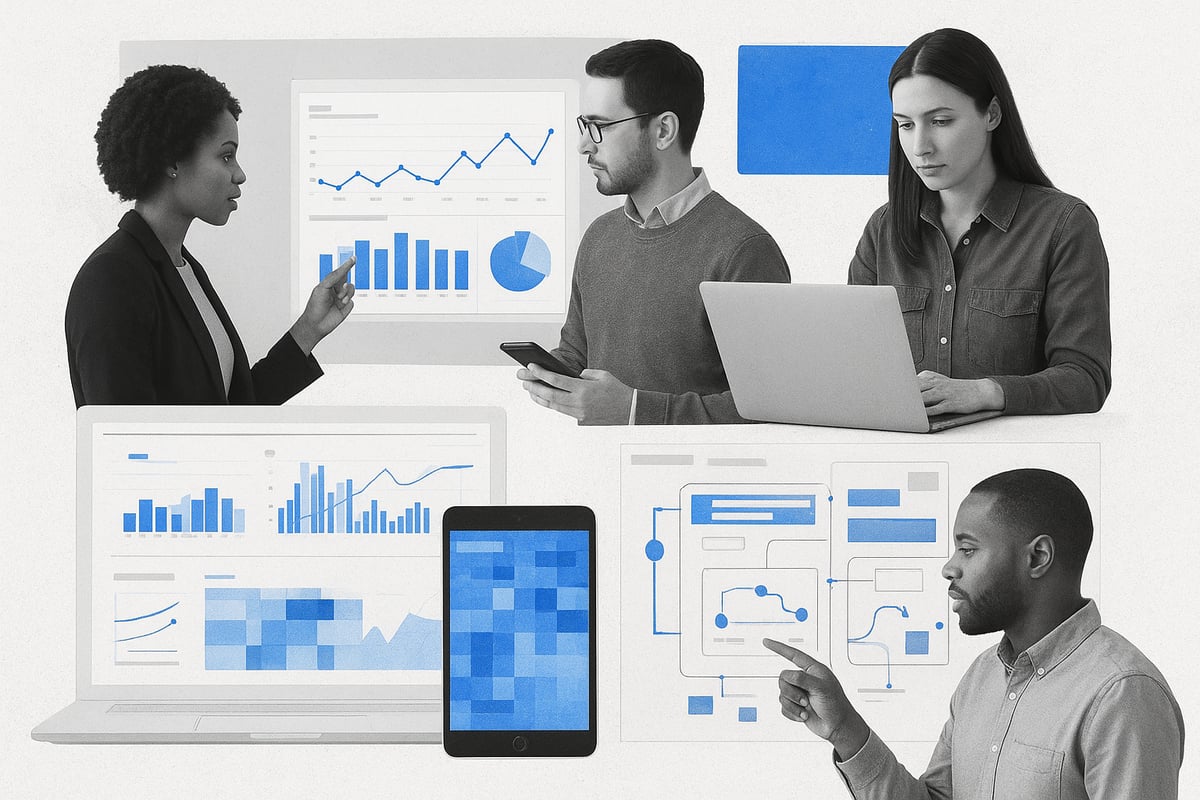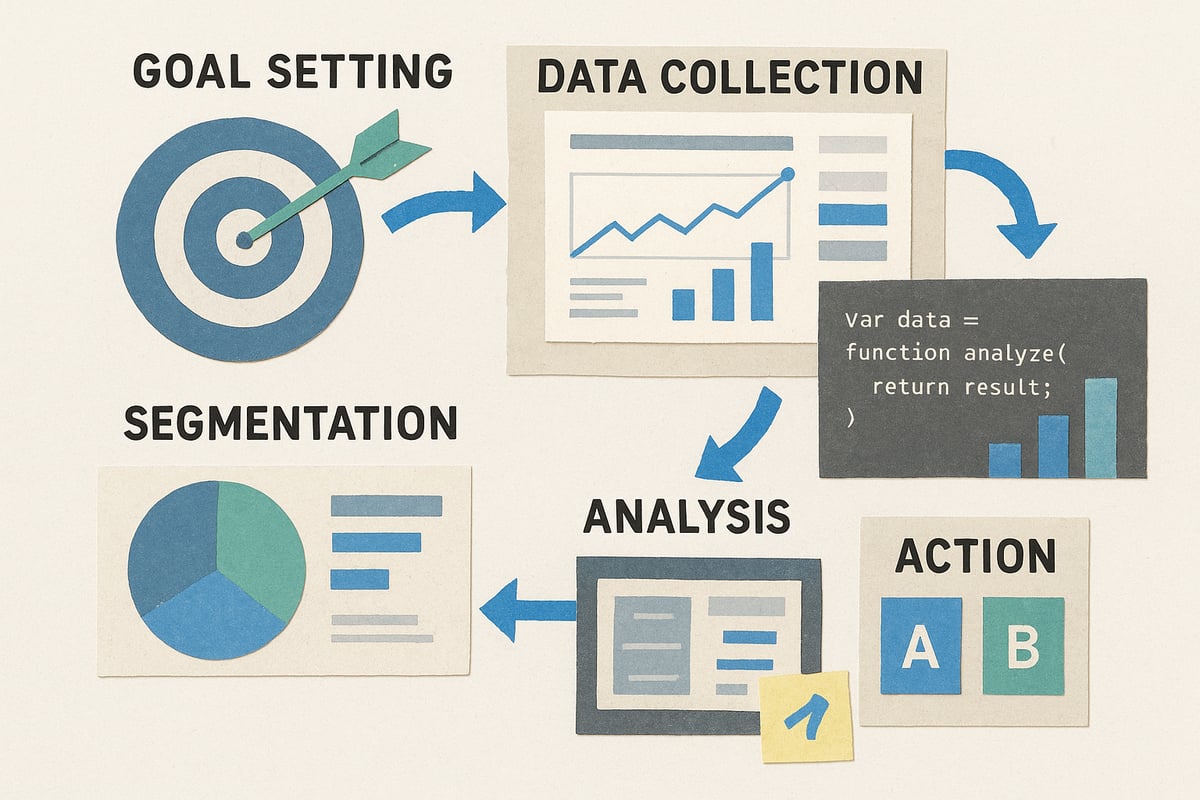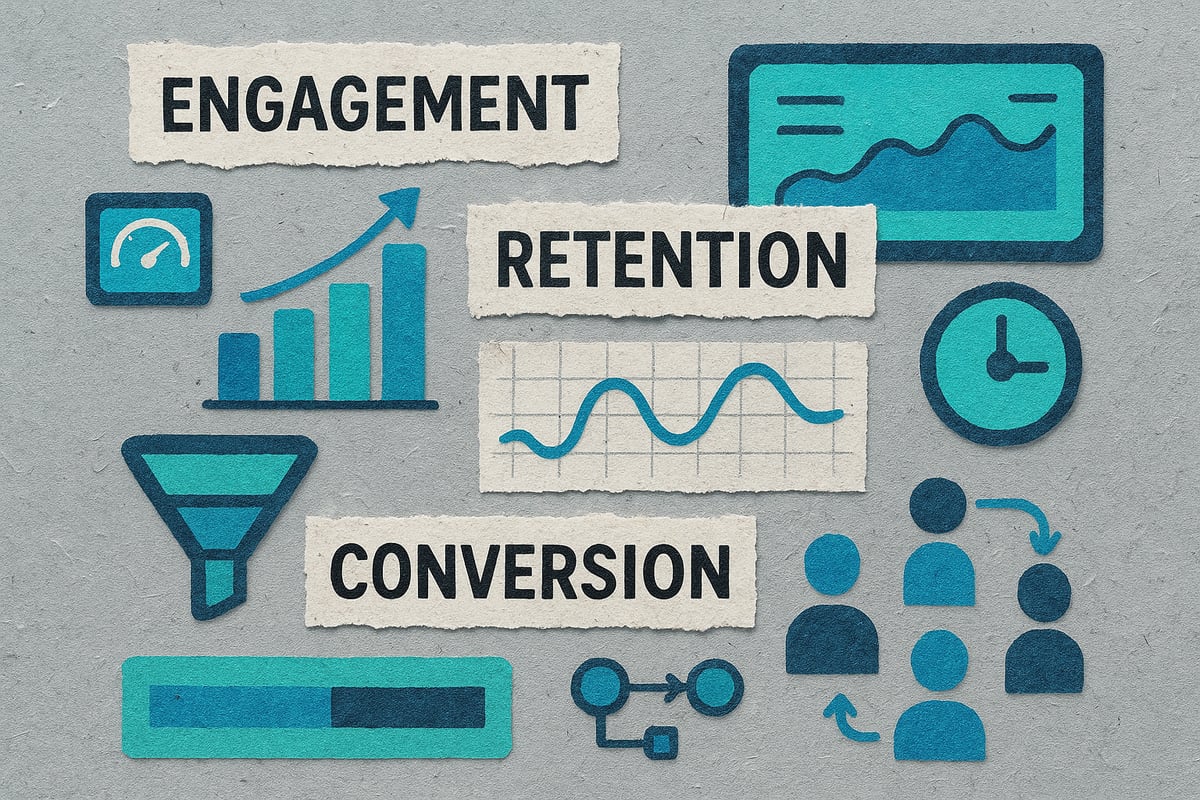- Date
User Analytics Guide 2025: Unlocking Actionable Insights
 Andrii Romasiun
Andrii Romasiun
In 2025, businesses are discovering that user analytics is the key to unlocking growth, driving engagement, and sparking innovation, all while respecting privacy. This guide will show you how user analytics has evolved from simple tracking to a powerful driver of strategic decisions. You will learn what user analytics is, who benefits most, and which frameworks and tools deliver the best insights in today’s privacy-focused digital landscape. By exploring real-world examples and proven strategies, you will gain the knowledge to turn data into impactful action and achieve a true competitive edge.
Understanding User Analytics in 2025
User analytics has become the backbone of digital strategy, shaping how organizations understand and optimize every user interaction. In 2025, businesses across industries rely on these insights to drive innovation, improve engagement, and stay ahead in a privacy-focused landscape.

What is User Analytics?
User analytics refers to the systematic collection, measurement, and analysis of user interactions across digital products. It goes beyond counting visits or clicks, focusing on understanding how users navigate, engage, and respond to features in real time.
There are two main types of user analytics: qualitative and quantitative. Quantitative analytics involve metrics like page views, session length, and conversion rates. Qualitative analytics, by contrast, focus on user motivations and experiences, often gathered through session replays, heatmaps, or surveys.
| Category | Description | Example Use Case |
|---|---|---|
| Segment Analytics | Group behavior analysis | Targeted marketing |
| Funnel Analytics | Mapping user journeys through key steps | Checkout optimization |
| Cohort Analytics | Tracking behavior of groups over time | Retention analysis |
The field has evolved from basic tracking to advanced behavioral intelligence. Segment analytics, for example, enable businesses to launch highly targeted campaigns by understanding distinct user groups. According to FullStory, user analytics can pinpoint both friction points and high-converting experiences, helping teams prioritize improvements.
User analytics now plays a pivotal role in product and marketing decisions. With digital journeys spanning devices and channels, analytics tools must provide a unified view across web, mobile, and even offline touchpoints.
For a deeper dive into actionable strategies and privacy-first approaches, see the User Analysis Guide: Strategies for 2025 Success.
Who Uses User Analytics and Why?
A wide range of stakeholders depend on user analytics to inform decisions and optimize outcomes:
- Product Managers: Identify feature adoption and prioritize the roadmap.
- Marketers: Personalize campaigns, optimize conversion funnels, and boost ROI.
- UX/UI Designers: Detect usability issues and refine user flows.
- Engineers: Prioritize fixes and reduce user friction.
- Customer Experience Teams: Measure satisfaction, spot drop-off points, and improve retention.
- SaaS Leaders: Drive engagement, reduce churn, and enhance onboarding.
For marketers, user analytics is essential for refining campaign targeting and messaging. Engineering teams leverage analytics to uncover usability bottlenecks and resolve issues before they impact users.
Customer experience teams monitor satisfaction scores and retention trends, while SaaS companies rely on user analytics to track engagement and decrease churn. For example, marketers often use analytics to adjust messaging and creative, ensuring campaigns resonate with their intended audience.
A recent FullStory report highlights that teams with access to user analytics make more informed and faster decisions. In today's competitive landscape, this data-driven agility can be the difference between leading the market and falling behind.
The User Analytics Process: From Data Collection to Insight
Understanding the full user analytics process is essential for transforming raw data into strategies that drive real business outcomes. Each step in this workflow builds upon the last, ensuring that insights are both reliable and actionable.

Step 1: Defining Goals and KPIs
Every effective user analytics initiative begins with clear objectives. Aligning analytics efforts with overall business goals ensures data collection is purposeful and results are meaningful.
Common KPIs include conversion rate, retention rate, churn, and user engagement. For SaaS businesses, tracking onboarding completion and monthly active users may be vital. Ecommerce teams may focus on cart abandonment and average order value.
To select the right metrics, use the SMART framework:
| KPI | Specific | Measurable | Achievable | Relevant | Time-bound |
|---|---|---|---|---|---|
| Increase trial signups | Yes | Yes | Yes | Yes | Yes |
For example, a SaaS team might map KPIs to each stage of the user journey, ensuring every metric supports growth. Avoid the pitfall of tracking vanity metrics, like total pageviews, if they do not drive real action. User analytics done right keeps teams focused on what truly matters.
Step 2: Data Collection Methods
Once goals are set, the next step in user analytics is gathering reliable data. Event-based tracking, pageview collection, session replay, and funnel tracking are all common methods. Teams typically use scripts, SDKs, or APIs to collect information from their digital products.
Combining quantitative data (like click events) with qualitative feedback (such as surveys or interviews) provides a more complete picture. Ensuring data completeness and accuracy is essential for trustworthy insights.
Session replay tools are powerful for visualizing user flows and understanding behavior in context. For a comprehensive overview of tracking methods essential to user analytics, see the Event Tracking Guide. Blending behavioral and sentiment data unlocks deeper insight into user motivations and friction.
Step 3: Data Segmentation and Filtering
After collection, user analytics relies on segmenting and filtering data for actionable analysis. Segmentation can be based on demographics, behavior, device type, source, or cohort.
By creating focused user segments, teams can target analysis and uncover patterns among high-value or at-risk groups. Funnel and cohort analyses reveal where users drop off and how retention trends shift over time.
For example, segmenting users by acquisition channel allows marketers to optimize spend and messaging. Filters help isolate the most relevant groups, ensuring that user analytics efforts are both efficient and effective.
Step 4: Analyzing and Interpreting Data
With segmented data in hand, teams move to analysis and interpretation. Trend analysis, conversion funnel visualization, and cohort comparison are standard techniques in user analytics.
Patterns and anomalies in behavior often reveal both friction points and opportunities. AI and machine learning can surface predictive insights, such as identifying users likely to churn.
Path analysis helps detect hidden obstacles in user journeys. To avoid analysis paralysis, prioritize actionable findings rather than getting lost in endless reports. Focused user analytics ensures teams act on data, not just observe it.
Step 5: Turning Insights into Action
The final stage of the user analytics process is translating findings into real-world improvements. This might mean adjusting a product feature, refining a marketing campaign, or streamlining the onboarding flow.
Setting up A/B tests allows teams to validate hypotheses before rolling out changes widely. Continuous feedback loops help track the impact of every adjustment and ensure ongoing optimization.
For example, iteratively improving onboarding based on analytics insights can boost retention and satisfaction. Measuring the outcome of changes closes the loop, proving the value of user analytics for business growth.
Essential Metrics and Frameworks for Actionable Insights
Unlocking actionable insights from user analytics begins with tracking the right metrics and applying proven frameworks. As digital experiences become more complex, selecting and interpreting these measurements is crucial for driving product and business success. Let us explore the essential categories every team should master.

Core Metrics to Track
Successful user analytics starts with a clear understanding of what to measure. Core metrics help you gauge product health, user behavior, and opportunities for improvement.
Engagement Metrics
- Active users (daily, weekly, monthly)
- Session duration and frequency
- Interaction depth (pages/screens per session)
Retention and Churn
- Retention rate by cohort
- Churn rate (percentage of users leaving)
- Return frequency over time
Conversion Metrics
- Funnel progression (steps completed)
- Goal completions (signups, purchases)
- Micro-conversions (feature usage, downloads)
Error and Friction Metrics
- Rage clicks (repeated, rapid clicking)
- Failed actions (errors, dead-ends)
- Exit points (where users abandon)
User Satisfaction
- Net Promoter Score (NPS)
- Customer Satisfaction (CSAT)
- Qualitative feedback from surveys or reviews
Here is a quick table summarizing these core metrics:
| Metric Type | What It Measures | Example Use Case |
|---|---|---|
| Engagement | Frequency and depth of use | Identify power users |
| Retention/Churn | Loyalty and user loss | Target at-risk users |
| Conversion | Goal achievement | Optimize onboarding |
| Error/Friction | Usability issues | Reduce drop-offs |
| Satisfaction | User sentiment | Prioritize improvements |
Using user analytics to track these metrics enables teams to spot friction, optimize funnels, and enhance user satisfaction.
Advanced Analytics Frameworks
After identifying the right metrics, user analytics becomes far more actionable with advanced frameworks. These models help teams move from raw data to strategic decisions.
Funnel Analysis
- Maps the user journey from entry to conversion
- Identifies where users drop off or succeed
Cohort Analysis
- Groups users by shared characteristics (signup date, feature use)
- Tracks behavior and retention over time
Segmentation
- Divides users by demographics, behavior, or source
- Enables targeted messaging and product changes
Customer Journey Mapping
- Visualizes the end-to-end experience across touchpoints
- Highlights pain points and moments of delight
For example, funnel analysis can reveal that a large percentage of users abandon checkout at the payment step, prompting targeted UX improvements. Cohort analysis might show that users acquired through organic search have higher long-term retention, informing marketing strategy.
Applying these frameworks allows user analytics to uncover not just what is happening, but why. Teams can test hypotheses, validate changes, and iterate based on evidence.
Interpreting Metrics for Business Impact
Collecting data is just the beginning. The true power of user analytics lies in interpreting metrics to drive real business outcomes.
Start by linking each metric to a specific business goal. For example, reducing friction in onboarding can increase customer lifetime value (LTV) and lower churn. Avoid vanity metrics that do not tie back to growth, such as total page views without context.
Companies that use advanced analytics frameworks see measurable gains. Retention improvements, for instance, often lead to higher revenue in SaaS businesses. According to industry benchmarks, organizations leveraging frameworks like funnel and cohort analysis outperform peers in conversion optimization.
To truly turn data into action, focus on insights that drive change. For a detailed guide on extracting actionable insights from user analytics, see User Insights Best Practices.
By prioritizing the right metrics, leveraging advanced frameworks, and interpreting findings through a business lens, teams can transform user analytics into a strategic advantage.
User Analytics Tools & Technologies: Choosing the Right Stack
Choosing the right user analytics stack is crucial for transforming raw data into actionable business intelligence. As businesses grow more data-driven in 2025, the right combination of tools can empower teams to uncover user behavior, optimize experiences, and drive measurable outcomes.
Key Features to Look For
The best user analytics tools in 2025 offer a robust set of features that address both technical and business needs. When evaluating solutions, prioritize these essentials:
- Real-time dashboards: Instantly monitor KPIs and user activity.
- Customizable reporting: Tailor data views for different teams.
- Event and funnel tracking: Follow specific user actions and map conversion paths.
- Session replay and journey visualization: See exactly how users interact with your product.
- Error and performance monitoring: Quickly identify and resolve friction points.
- Integrations: Seamlessly connect with CRM, marketing, and support systems.
- Role-based access: Ensure the right data reaches the right stakeholders.
These features enable organizations to gain a holistic view of user analytics across products and channels. Prioritizing them ensures your stack can adapt as your data needs evolve.
Leading Analytics Platforms in 2025
Several platforms stand out in the user analytics landscape, each offering unique strengths for different business contexts. Here is a comparison of the top solutions:
| Platform | Strengths | Weaknesses | Best Use Case |
|---|---|---|---|
| FullStory | Session replay, friction detection, robust integrations | May be complex for small teams | UX optimization, product teams |
| Mixpanel | Advanced event tracking, funnel analysis, strong segmentation | Learning curve for beginners | SaaS, mobile apps |
| Amplitude | Cohort analysis, user journey mapping, collaboration tools | Can be pricey at scale | Growth analytics, enterprise |
| Google Analytics alternatives | Privacy options, large ecosystem, ease of use | Limited behavioral depth | Ecommerce, content sites |
If you are looking for more context on how user analytics tools differ from traditional web analytics, What is Web Analytics provides a helpful primer.
Swetrix: Privacy-First Analytics for Actionable Insights
Swetrix is redefining user analytics for privacy-conscious organizations. Unlike many platforms, Swetrix operates without cookies and requires no consent banners, ensuring full compliance with GDPR and similar regulations. Its open-source and self-hostable options offer complete data ownership and control.

Key Swetrix features include:
- Intuitive dashboards for real-time insights
- Custom event tracking to monitor any user interaction
- Error monitoring and funnel visualization for actionable feedback
- User flow analysis to identify and remove friction
Swetrix is ideal for businesses that need user analytics without compromising privacy or legal compliance. For example, a privacy-first SaaS company can use Swetrix to optimize onboarding and boost engagement, all while protecting user trust.
Matching Tools to Your Needs
Selecting the right user analytics solution depends on several factors:
- Business size and complexity: Startups may prefer open-source or lightweight tools, while enterprises often need scalable, feature-rich platforms.
- Privacy requirements: Consider tools like Swetrix if regulations or user expectations demand strict compliance.
- Technical resources: Ensure your team can implement, maintain, and act on the insights provided.
- Integration needs: The best user analytics stack fits seamlessly into your existing workflow.
As privacy regulations evolve, many organizations are shifting toward privacy-first analytics platforms. Carefully assess your priorities and choose tools that not only deliver deep insights but also align with your values and legal obligations.
Privacy, Ethics, and Compliance in User Analytics
Understanding privacy, ethics, and compliance is now central to user analytics. As digital regulation evolves, businesses must adapt their analytics approaches to maintain user trust and remain compliant.
The Evolving Privacy Landscape
The global regulatory environment for user analytics is rapidly changing. Regulations such as GDPR and CCPA have set high standards for data protection, and in 2025, new laws are emerging across more regions. Businesses are now expected to provide transparent data practices and prioritize user consent.
These changes have a direct impact on how user analytics tools are implemented. Cookie consent banners, data minimization rules, and the need for explicit user permissions are now common requirements. For example, analytics platforms must ensure that only necessary data is collected and that users can easily opt out.
To stay compliant and competitive, companies often revisit their analytics strategies. Many are adopting privacy-first technologies and updating workflows to align with the latest regulations. For a deeper dive into how regulations and best practices are shaping automated analytics, see How Global Regulations and Technical Best Practices Are Changing Automated Analytics in 2025.
Privacy-First Analytics Strategies
To address privacy concerns, organizations are shifting to privacy-first user analytics solutions. Cookieless tracking, anonymous data collection, and data minimization are becoming standard. By collecting only essential data, businesses reduce risk and improve user trust.
Open-source and self-hosted analytics platforms offer full data control, supporting compliance with laws and internal policies. Many companies are also exploring solutions that eliminate the need for cookie banners altogether. This approach not only streamlines the user experience but also ensures that analytics insights remain actionable without sacrificing privacy.
Switching from traditional tracking to privacy-compliant analytics tools can be a significant move. It often involves rethinking data collection, integrating new platforms, and updating internal processes. For practical strategies and examples of privacy-first analytics, see Privacy-Friendly Analytics Explained.
Balancing Insight and Ethics
Ethical considerations are inseparable from user analytics in 2025. Transparent data usage, clear user consent, and responsible data handling are critical for building long-term trust. Users increasingly expect brands to respect their privacy and be open about how their data is used.
According to industry research, 75% of consumers are more likely to engage with brands they trust to handle their data ethically. Over-collecting data not only increases compliance risks but can also erode user confidence. The right balance is achieved by focusing on collecting and analyzing only what is necessary to improve user experience and business outcomes.
By embedding ethics into user analytics practices, organizations can maintain compliance, foster trust, and drive sustainable growth.
Turning Analytics Into Action: Best Practices and Future Trends
Turning user analytics into concrete business impact requires more than collecting data. It takes a focused strategy, cross-functional collaboration, and a commitment to continuous improvement. As we look to 2025, mastering the art of actionable insights will be the difference between companies that lead and those that follow.
Building a Data-Driven Culture
A thriving data-driven culture is the foundation for maximizing user analytics. Teams must break down silos and foster open communication between product, marketing, engineering, and customer experience departments. Training is essential, ensuring everyone can interpret and act on user analytics findings.
Regular analytics reviews and feedback loops encourage a mindset of experimentation. When user analytics becomes part of daily decision-making, organizations move faster and learn from every touchpoint.
Actionable Workflows
To extract real value from user analytics, prioritize insights that deliver measurable business impact. Integrate analytics into agile product sprints and UX design cycles, allowing rapid iteration. For example, continuously optimize onboarding flows based on real-time user analytics data.
Key steps for actionable workflows:
- Identify high-impact opportunities from analytics reports.
- Test hypotheses with A/B and multivariate experiments.
- Implement changes quickly and measure outcomes.
- Create feedback loops for ongoing refinement.
Emerging Trends in User Analytics for 2025
The future of user analytics is being shaped by cutting-edge technologies and rising privacy expectations. Artificial intelligence and machine learning are driving predictive insights, enabling businesses to anticipate user behavior. Real-time personalization tailors experiences as users interact across channels.
Privacy-enhancing technologies, such as differential privacy and edge analytics, are gaining traction. The growing need for multi-touch and omnichannel analytics reflects today’s complex customer journeys. For more on these trends, see Top 5 Web Analytics Trends Expected to Dominate in 2025.
Common Challenges and How to Overcome Them
Implementing user analytics is not without obstacles. Data silos and integration issues can limit insight. To overcome this, invest in unified platforms that centralize data. Ensuring data quality and avoiding bias requires regular audits and diverse data sources.
Analysis paralysis is another common pitfall. Focus on actionable metrics, not just surface-level numbers. Resistance to data-driven change, especially in legacy organizations, can be addressed through education and clear demonstration of user analytics benefits.
Measuring Success and ROI
Demonstrating the value of user analytics means linking insights to tangible business outcomes. Set clear benchmarks and track improvements after implementing analytics-driven changes. Use a mix of quantitative and qualitative metrics to get a holistic view.
| Metric | Before Analytics | After Analytics | Improvement (%) |
|---|---|---|---|
| Conversion Rate | 2.5 | 3.2 | 28 |
| Retention Rate | 60 | 75 | 25 |
| Churn Rate | 8 | 5.5 | -31 |
For example, a company may increase conversions by 30 percent after refining its onboarding based on user analytics insights. Industry benchmarks show that businesses with robust user analytics practices are twice as likely to outperform competitors.
You’ve seen how user analytics is evolving in 2025—privacy, actionable insights, and ethical data practices are no longer optional. If you’re ready to harness meaningful user data without compromising compliance or user trust, it’s time to explore a platform built for these new standards. With intuitive dashboards, cookieless tracking, and full data ownership, you can turn insights into real business growth while respecting your users. Why wait to see the difference a privacy-first approach can make for your team and your users? Try Swetrix today